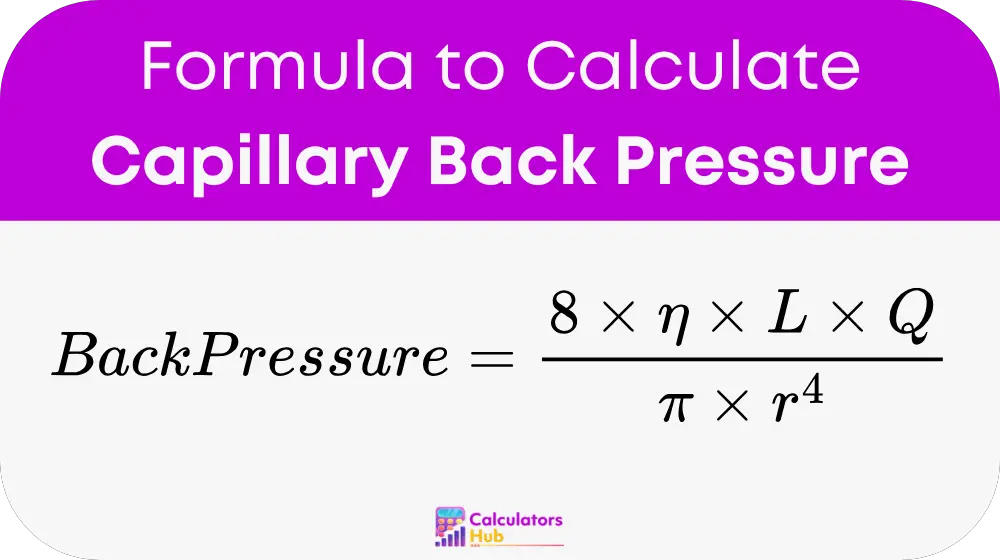The Capillary Back Pressure Calculator is a valuable tool used in fluid dynamics to determine the pressure that a fluid experiences as it moves through a capillary tube. This pressure, known as capillary back pressure, is critical in various applications, including biomedical engineering, microfluidics, and materials science. By understanding how back pressure influences fluid flow, engineers and scientists can design more efficient systems, such as blood flow in medical devices or ink flow in printers. This calculator provides a straightforward method to calculate back pressure based on specific parameters, ensuring accurate assessments in various engineering and research contexts.
Formula of Capillary Back Pressure Calculator
The capillary back pressure can be calculated using the following formula:

where:
- Back Pressure is the pressure in pascals (Pa)
- η is the dynamic viscosity of the fluid in pascal-seconds (Pa·s)
- L is the length of the capillary tube in meters (m)
- Q is the volumetric flow rate in cubic meters per second (m³/s)
- π is the mathematical constant pi, approximately 3.1416
- r is the inner radius of the capillary tube in meters (m)
General Terms Table
The following table provides common terms related to capillary back pressure and fluid dynamics. This can serve as a helpful reference for users without needing to perform calculations each time.
| Term | Definition |
|---|---|
| Back Pressure | The pressure that opposes the flow of fluid in a capillary tube, measured in pascals (Pa). |
| Dynamic Viscosity (η) | A measure of a fluid's resistance to flow, expressed in pascal-seconds (Pa·s). |
| Length of Capillary Tube (L) | The distance the fluid travels inside the capillary, measured in meters (m). |
| Volumetric Flow Rate (Q) | The volume of fluid flowing per unit of time, expressed in cubic meters per second (m³/s). |
| Inner Radius (r) | The radius of the capillary tube's inner diameter, measured in meters (m). |
| π (Pi) | A mathematical constant approximately equal to 3.1416, used in circular calculations. |
Example of Capillary Back Pressure Calculator
To illustrate the use of the Capillary Back Pressure Calculator, consider a scenario where the following data is available:
- Dynamic Viscosity (η): 0.001 Pa·s (typical for water)
- Length of Capillary Tube (L): 0.5 m
- Volumetric Flow Rate (Q): 0.0001 m³/s
- Inner Radius of Capillary Tube (r): 0.01 m
Using the formula:
Back Pressure = (8 * η * L * Q) / (π * r^4)
Substituting the values:
Back Pressure = (8 * 0.001 * 0.5 * 0.0001) / (3.1416 * (0.01)^4)
Back Pressure = (0.000004) / (3.1416 * 0.0000000001) ≈ 127.32 Pa
In this example, the capillary back pressure is approximately 127.32 pascals, which provides insights into how much pressure is required to maintain the specified flow in the given capillary tube.
Most Common FAQs
Capillary back pressure is influenced by several factors, including the fluid's dynamic viscosity, the length and radius of the capillary tube, and the volumetric flow rate. Changes in any of these parameters can significantly impact the back pressure experienced by the fluid.
To reduce capillary back pressure, you can consider increasing the diameter of the capillary tube, reducing the length of the tube, or using a fluid with lower viscosity. Additionally, optimizing the flow rate can also help manage back pressure effectively.
Capillary back pressure is crucial in medical devices because it affects fluid delivery and absorption rates, such as in intravenous (IV) systems or drug delivery devices. Understanding and managing back pressure ensures that these devices function safely and effectively.